|
|
|
|
Using phantom money, the Ion trading Blue colored Line consisted of 19 buys and 19 sells and 20 shorts (20 shorts and 20 covers for the short) per stock for a total of 78 trades per stock from the start of January 2000 to the end of June 2000 (6 months). By buying when the forecast was in the middle of a negative ion ratio and selling when it was in the middle of the positive ion ratio (usually a few days later) and then immediately beginning a short from positive back to negative then again buying in the middle of the negative... This method of Ion trading out performed 41 of the 50 stocks listed. Each stock was traded at the end of the same day and these trades were based on nothing more than the Forecasted Ion Ratio given in advance on www.SuperForce.com. The Plum colored Line represents the actual stock performance for the same six month period of time.
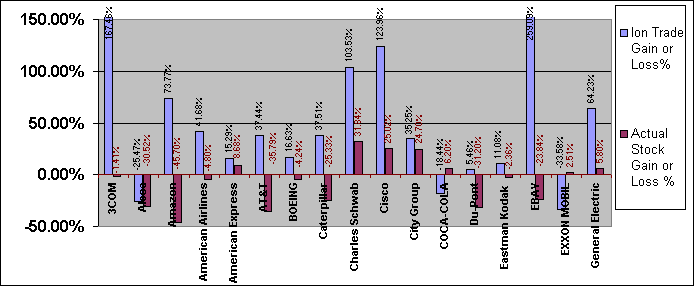
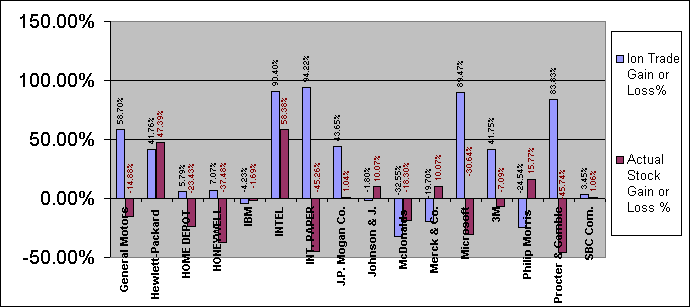
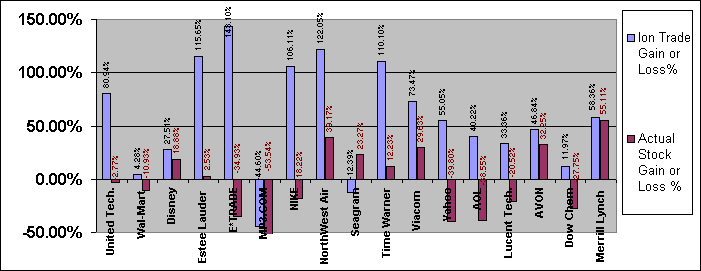
This method of trading requires two weeks of advanced notice with the Ion Ratio Forecast given on SuperForce.com. The current SuperForce.com forecast only gives one week in advance. By using the existing one week Ion Trading method in six months your return on these 50 stocks would be a 15.01% increase, while using the two week method would have shown a 47.28% increase, more than three times higher. This new two week method data will be available from SuperForce.com for $39.95 per month, see end of article.
A short is where you place the order to buy
(short) when you expect a stock has peaked and actually buy the stock (cover) when you feel it
is at a low, your essentially hedging that the stock will lose value and
personally gaining on the loss. However if the stock actually increased in value
when you tried to short you must buy the stock (cover) at the higher value and cover the
difference from your buy order to the gain, meaning a personal loss on an
unsuccessful short.
|
Initial Investment |
$500,000 |
Initial Investment |
$500,000 |
Initial Investment |
$500,000 |
|
If you invested
$10,000 into each of the 50 stocks and made the 78 trades (blue line) with
each stock according to the two
week method Your six month Total to 6/30/00 |
$736,419 |
If you invested
$10,000 into each of the 50 stocks and made 78 trades with each stock
using the one week method: Your six month Total to 6/30/2000 |
$575,517 |
If you invested
$10,000 into each of the 50 stocks Jan 3, 2000 with each stock and left
you’re your investment in each stock without any trades (Plum
Line):Your six month Total to 6/30/2000 |
$478,486 |
|
Profit |
$236,419 |
Profit |
$75,517 |
Loss |
-$21,513.88 |
|
%Increase |
47.28% |
%Increase |
15.10% |
%Decrease |
-9% |
|
Expected 1 Year
Gain |
94.57% |
Expected 1 Year
Gain |
30.20% |
Expected 1 Year
loss |
-21.84% |
If we had invested in just the 30 Dow
Jones Industrial stocks which are all listed in the graphs with $10,000 each and
made 78 trades (two week method) with each stock (all at the end of the same
days) we would have shown a 24.51% gain although the Dow Jones Index in the same
six month actually dropped –5.35%
Out of the Dow Jones Ind. 30, we would have had 8 stocks that lost value, and 22 that gained.
Out of the 50 stocks listed above using the two week method, we would have lost on only ten and gained on 40 of the 50 (80% success rate). By buying the all 50 stocks and not trading any of them, only 21 (42%) of the 50 stocks actually gained in value.
The following is a recap of the trading
performance on the 50 stocks. For instance in the three charts there were 9
stocks that increased above 100% which means 18% (9 of 50) of the stocks tested
performed above 100% after 6 months of using the two week method.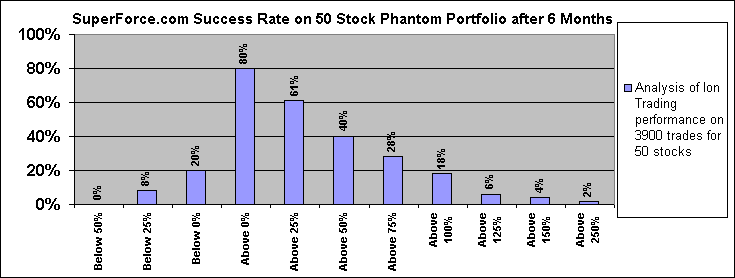
Please note that we did not factor in any cost per trade, which can vary from a few dollars to over $50.00 per trade with some brokerage firms. 78 trades at $50.00 per trade is $3,900 in six months for one stock, where $8.00 per trade on 78 trades is $624 for six months. If you are considering trading with either method make certain that the investment is enough to also cover the trading cost. Some phantom portfolios (pretend money and stock) actually factor in a phantom cost per trade to make it more realisic.
Does Ion Trading Work?
Consider that after one year a good return on a mutual fund is an 8-10% gain. However, out of the 50 stocks, 40% (20 of the 50 stocks) showed a greater than 50% gain in just six months and none of the 50 were below a 50% loss! Each of the 50 stocks was traded 78 times on the exact same days for a total of 3900 trades.
The difference in growth between May 31, 2000 and June 29, 2000 remained relative as the increase at the end of May was 39.41% (x 2.4 for the year) = 94.59% increase for the expected one year gain. By the end of June, one month later (50 stocks x 14 trades for each stock in June = 700 trades) the increase at the end of June was 47.28% (x 2 for the year) = 94.57% increase for the expected one year gain. Only a difference in the expected one year gain of .02% in one month.
To date the growth rate using the two week method of ion trading on these 50 stocks is at 7.88% gain per month. While the one week method only shows a 2.51% gain per month. If a good yearly return on a mutual fund is 7% - 8% then the two week method could out perform it by a factor of 12x in a year.
Of course seeing that some stocks work better than others with the ion trading method one could potentially show a much higher increase. The reason 50 stocks were chosen was so that the portfolio was diversified enough to show a true representation. All 30 Dow Jones Industrial stocks were used as well as some of the more recognized stocks such as 3com, AOL, Lucent, Yahoo…
The prerequisite for picking a stock is high volume each day. Someone asked us to try a Vancouver Stock with High Volume called Edispatch.com Wireless Data Inc., which trades on the Canadian Exchange. We went back and calculated the same 78 trades and showed a 272.60% increase on the two week method and a 776.43% increase with the one week method, (this is one of those rare cases where the one week method worked better than the two week) meaning if we began with a $10,000 investment at the beginning of January, we would now have $87,642.93 six months later using the one week method. Part of the reason for this massive increase is the exponential growth. Like compound interest, we are reinvesting the profit or loss with the initial $10,000 each time we trade, so a 10% gain in the stock at the start would have been $1,000 dollars but six months later a 10% gain on the stock with an investment of $87,642.93 is now $8,764 dollars.
We then ran Nortel Networks, which makes up about 30% of the Toronto Stock Exchange and showed a 189.23% increase using the two week method and a 115.07% increase with the one week method. Nortel stock value in the same 6 month period increased 57.26%.
We then ran another large Canadian stock BCE Emergis and showed a 422.69% increase using the two week method and a 215.74% increase with the one week method. BCE Emergis stock value in the same 6 month period increased 15.59%.

If you were able to invest into the four Market Indexes, Dow Jones Ind., NASDAQ, S&P 500 and the TSE 300, SuperForce.com utilizing the 78 trades for each index outperformed all four.
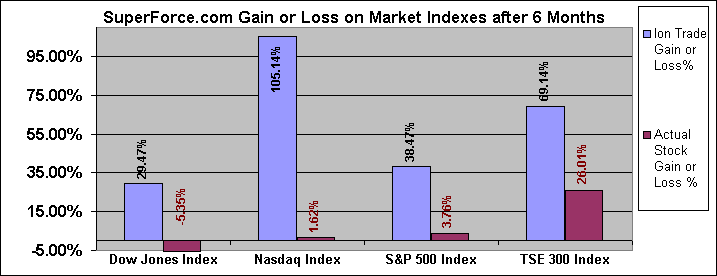
Although you cannot invest into the indexes this way, you can buy stocks that trade based on the Index performance. For the NASDAQ 100 index the stock is called QQQ, for the S&P 500 the stock is called SPY, Both the TSE and the S&P Indexes are merged into a new stock S&P/TSE 60 Index Participation Fund which started in the middle of January trades under the symbol XIU on the Toronto Exchange.

Index based trading should be much more stable (safer) than individual stocks which can unexpectedly fluctuate on press releases, expected earnings, news stories… It is also much cheaper as you only pay for 78 trades for one stock. As such a $50,000 investment in January 2000 into QQQ with the 78 trades based on the two week method your investment would be $106,175 six months later. If we factor in a trade cost of $50.00 per trade on the 78 trades then the return is 101.14% gain and the investment would be $100,569 six months later. So on $50,000 we lose about 11% of the gain to (high end) trading costs. If we only initially invested $10,000 in the QQQ the return based on $50.00 per trade, the return drops to a 56.30% gain ($15,630 total). The larger investment offsets the trading costs incurred.
Many brokers and financial institutions are expected to endorse this method regardless of their opinion of whether it works or not as they make their money from the trades, the more trades made the more money they receive. Beware of "churning", it is the excessive trading by a broker- usually unauthorized- that is generated primarily for the commissions. The courts view the unacceptability by analyzing whether the transactions of purchase or sale were excessive in size or frequency in view of the financial resources and character of a customer's account. Most churning occurs where a broker has discretion to trade the account. In such cases, it is not necessary that the broker receive prior approval from the client for completing a transaction.
Apparently the courts have held that a broker/dealer cannot normally be held liable for overtrading of an account where the transactions are initiated by the client.
Though most churning involves trades of individual securities, the SEC also discourages the trading of mutual funds on a short term basis. Mutual funds are, for the most part, still considered longer term investments. Short term trading of a loaded mutual fund can result in commissions as high as 8 1/2%
We recommend using free phantom portfolios, as you are not actually trading real stocks.
Does the Ion Ratio have a Global effect?
We ran the following World Indexes to see if the same ion ratios were global in scope: Hong Kong, Japan, United Kingdom, German, Norway, Israel, Moscow, Australia, South Africa, Brazil, Mexico, Argentina, India, and New Zealand. These countries would display the six continental areas in both the Northern and Southern hemispheres, giving a more accurate representation of the World.
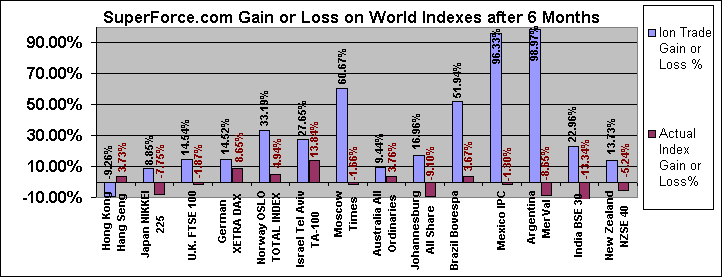
We out performed 13 of the 14 Indexes shown. The same 78 trading days were used with the two week method. When holidays or non trading days occurred with each World Index when an ion trade should have taken place we picked the next closest day as a substitute. Most World Indexes only required one or two substitutes out of the 78 trades.
What does all this mean?
The stock markets have appeared to be random with market factors influencing the daily gains and losses. However, human behavior appears to have a greater influence on the stock markets and human behavior is affected by the Global Ion Ratios. These ion ratios fluctuate and can be forecasted as a series of mathematical algorithms (repeating equations) can be found in an easy to read format on the SuperForce.com site.
The SuperForce.com site has been forecasting the Ion Ratio Forecast since January 3, 2000 giving the forecast in advance of the upcoming week. Anyone can come back to the site the following week and verify that the forecasted information was not changed to match the sports or stock market indexes after the fact.
The Parent company of the SuperForce.com site is United Dynamics Corp., a Joint Aerospace Science company, operated by the President of the company, Guy Cramer, who is credited with the discovering the Ion Ratio Forecast in 1993 and is also credited with discovery of the correlation of the Ion Ratio Forecast with athletic performance, health problems such as asthma, depression, diabetes, road rage and migraine headaches, behavioral changes in humans, animals and insects, and the correlation of the Stock Markets.
The web site www.superforce.com will continue the free one week forecast, but for the interested person we will now provide one month of forecasted data in advance for $39.95 USD a month which utilizes the same advanced two week method shown here. As an introductory offer, this new service is available free for the month of August. To subscribe to the advanced monthly SuperForce.com data please visit the web site near the end of August.
We have post links with the service to web sites that allow phantom portfolios.
![]()
SuperForce, Surface Ion Ratio Forecast, and United Dynamics are Trademarks of United Dynamics Corp.
This information, graphics and text are © 1999, 2000 United Dynamics Corp., All Rights Reserved